Events and excursions, Summer 2013
Ashfield Heritage Trail - Saturday, 15 June 2013
by John Wilson
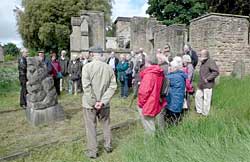
Thoroton members at Old Annesley church with the memorial to George Chaworth-Musters to the left.
Around 38 Thoroton members set off from Nottingham in a splendid and very comfortable Sharpe's coach for the Ashfield area. On the way we stopped to pick up Denis Hill, the Heritage and Development officer for Ashfield District Council who proved to be a most knowledgeable and amusing guide for the day.
We first stopped at Annesley Old Church. Many people must pass along the approach road to junction 27 of the M1 without knowing that they are so near to such a treasure. Annesley Old Church is now a ruin, but is grade 2* listed. Many of the monuments were removed to the Annesley New Church, built in 1874 to serve the mining community. The site of the old church is now a nature reserve. The monuments in the graveyard were recorded in the late 1980s. One of the most interesting is that to George Chaworth-Musters, who travelled to Patagonia and carried out one of the first surveys there. He spent much time with the local people and achieved the nickname of King of Patagonia. Annesley Hall, where Lord Byron was a regular visitor, stands next to the church. D. H. Lawrence also had connections with Annesley.

Fly-ash blocks at Jacksdale wharf.
The coach passed through Bagthorpe and Selston but without stopping. Denis described the architecture of St. Helen's church, Selston as we passed. The party then travelled to Jacksdale where coffee was served in the village hall, and where we were able to see the early industrial tramway, built to serve the iron industry. The tramway conveyed coal in horse-drawn wagons from the Portland pits via the Mexborough pits to Jacksdale. There, the coal was loaded onto barges for transport along the Cromford Canal. We inspected the site of the canal basin, now filled-in but still visible and the unusual tramway embankment made of slag-blocks from the iron foundry. At this point the heavens opened, and some very damp Thorotonians returned to the coach!
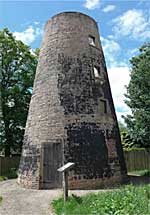
Lindley's Mill.
Our next stop was in Sutton-in-Ashfield, to view one of Sutton's hidden treasures, a windmill, known locally as Lindley's Mill. Now disused, and with no cap, it is hidden down a small road and is so well concealed that it does not appear on any maps. [It can be seen on Google maps' satellite page at the end of Prospect Place off High Pavement, Sutton: Ed.]. The mill was built in 1820 to replace a post mill that had been blown down in a gale in 1818. We then passed Sutton pinfold and travelled through Huthwaite. Denis informed us that a conservation project was planned here.
The highest point in Nottinghamshire was next - Strawberry Bank, at a height of 203m above mean sea level. This is the highest natural point in the county, but the nearby Silverhill Mount, made out of mining spoil, is marginally higher and is topped by a memorial to the miners.
Lunch was taken at the Manor Room in Teversal, and was followed by a visit to St. Katherine's church next door. The spelling of the name is not the only unusual feature of this remarkable church. There are 17th century box pews and a very fine Norman arch, with intricate carvings, at the south door. The current owners of Teversal manor opened their magnificent gardens for us to inspect and our thanks are due to them for this.
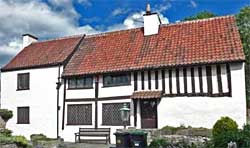
Cruck cottage, Skegby. (Photos by Howard Fisher).
Our last stop was at Skegby, where we followed the Skegby Heritage Trail. We had an opportunity to view the 17th century Quaker House, once home of Elizabeth Hooton, one of the founders of the Quaker movement in England. The Skegby Manor House, now a ruin, dates from the early 13th century and Cruck Cottage, still occupied as a private house, from at least the 16th century. This is the oldest permanently residential cruck-built cottage in Nottinghamshire. The cow-shed and dovecote in the Cruck yard have been converted to cottages. The Skegby Troughs, used to provide drinking water for animals, were also inspected. The troughs are fed from a natural spring and the site has been restored recently by the Skegby Appreciation Society.
Finally, tea and coffee were served at the Badger Box pub on the way back to Nottingham.
Thanks are due to Denis Hill of Ashfield District Council for his excellent running commentary and to Derrick and Ceril Little for organising this excursion.
Brodsworth Hall and Rotherham Minster
By Alan Langton (who lead the outing)
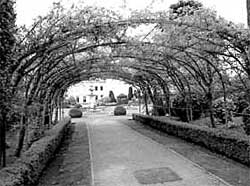
Brodsworth gardens.
The pleasant journey up the A1 towards Doncaster allowed members to appreciate the beauty of the rather late Springtime, as we passed through Clumber and the open countryside.
At Brodsworth we enjoyed coffee or tea and home-made biscuits – straight from the oven. We were privileged to have a private guided tour through the ground floor rooms of this extravagant Victorian house built by Charles Sabine Augustus Thelluson. The rooms are laid out more or less as they had been left after the family moved out, and the tour gave us a realistic view of the opulence enjoyed by the family and those who worked for them on the estate.
Our visit coincided with an exhibition of how the house was used during the war by a succession of army units, and so we were told, for example, how the dining room became the officers’ mess, and how the local people and the soldiers worked together and used the large house in their duties and during their leisure time.
After our buffet lunch, we had the opportunity to continue touring the house, especially the upstairs rooms, and the grounds on our own. The gardens are magnificent, with splendid displays of Spring flowers, and an intriguing grotto which is being restored by English Heritage.
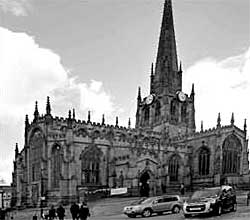
Rotherham Minster.
After a short journey to Rotherham, we were treated to a knowledgeable and moving personal talk by the Verger of Rotherham Minster: his love for the church and its history shone through all he said. The building’s origins go back to pre-Norman times and the creation of a fine perpendicular building onto the original structure is clear to see. The Minster is in the centre of the town and well used not just for worship but for other social activities regularly.
Our visit was being followed by a gathering of Yorkshire Bell-ringers for an annual service, and Thoroton members were able to hear the twelve bells being rung and the fine Snetzler organ being played before the service began.
See John Wilson's article on the poppyheads at Rotherham Minster.
The Special Event, Newark Town Hall, ‘Laxton & Kibworth: a Story of England’ by Michael Wood
Hannah Nicholson reports on the very well attended evening at Newark on 18 July 2013

On the evening of the 18th July, Thoroton members along with those from the Laxton History Group gathered in the ballroom of Newark Town Hall to hear historian and broadcaster Michael Wood talk on the subject of Kibworth, Leicestershire and Laxton, Nottinghamshire. This was a particularly significant event for the Laxton History Group as it coincided with their 50th meeting. To date, Michael has made over 100 television documentaries on a variety of subjects including Alexander the Great, the Trojan War and more recently Domesday as well as Shakespeare. The Story of England, was broadcast by the BBC in 2010 and was filmed largely in Kibworth but the open fields of Laxton were also featured.
Kibworth may not at first seem the obvious place in which to set the story of England but thanks to the influence of Merton College, Oxford, the landowner of the village for much of its history, the manorial records of the parish are incredibly well preserved. Given that these documents are largely complete, Michael showed how Kibworth was the ideal location in which to film the history of England and the story of its people. Whilst Kibworth is blessed with an almost complete set of court rolls, Laxton, as many will know, is the last surviving example of an open field system still operating in England. A clip from Michael’s documentary featured Laxton and provided an insight into the Court Leet along with the management and running of the field system. The filming of The Story of England was not Michael’s first visit to Laxton and his link with the village dates back to the 1980s. In recognition of this longstanding association with the village, Michael was promoted to the position of ‘Stakeholder’. He was presented with its sign of office - a mini stake made from one which had once marked the boundary of Mill Field, Laxton.
In his lecture, Michael explained how he aimed to tell the whole story of England from the Roman period to the twentieth century by looking at one place through the eyes of its people rather than those of the ruling elite. By involving current residents of Kibworth, some of whom could trace their families back within the village to the Norman Conquest, Michael highlighted the importance of local history in informing us about the wider history of England and its people. Largely through archaeological excavations, The Story of England uncovered the village’s history which in turn was the history of us all.

Part of the audience in the Ballroom at Newark Town Hall for the lecture (Photos by Howard Fisher).
Partly as a result of The Story of England, many more villages and communities have developed an interest in local history and community archaeology renewing interest and discussion to the field. In many cases these small scale projects at a local level have been aided by the financial support of the Heritage Lottery Fund whereby some villages have been able to produce books and pamphlets regarding subjects of local interest. To see Michael’s work at both Laxton and Kibworth in helping this resurgence of interest in local history is very encouraging and should be applauded. Thanks go to the Society for organising the event along with the refreshments following Michael’s lecture. Thanks also must be paid to David Hoskins for handling the technology and PowerPoint during the lecture.
Those interested in the evening’s lecture and wishing to know more about Kibworth should be encouraged to buy Michael’s book entitled The Story of England RRP £9.99. (2010) ISBN: 0670919047.
Archaeology and Landscape in the Trent Valley, 15 May 2013
A full conference report by Howard Fisher is available here.
Transport and Trade on the Trent 1850 – 1970
A meeting report by John Wilson.
This new project is the result of a significant award to the University of Nottingham from the Arts and Humanities Research Council. The grant is part of the AHRC’s Connected Communities programme, and will run for one year. The University is working in collaboration with local history societies, waterways heritage groups and individuals to produce a comprehensive survey of the Trent since the mid-nineteenth century, which will be published as a book in due course.
A day-school was held on Saturday 18 May 2013 at the Newark Academy to launch the project and to enable interested individuals and groups to find out more about it. The day, which attracted some eighty participants, was chaired by Dr. Richard Gaunt.
Philip Riden introduced the project which will look at the management of the Trent and associated waterways including canals, the organisation of the various carrying trades on the river, and life on board boats and in the riverside communities. The impact of the rise of the railways from the mid-Victorian era and that of road transport will also be examined. Philip pointed out that very little has been written about the impact on water traffic of the increase in road transport after 1918. He described the many sources of information available for research into the recent history of the Trent. Much of the material is widely dispersed; many records are in the National Archives at Kew, and a research assistant has been appointed to carry out studies at Kew and elsewhere on behalf of the project. There is a significant Waterways Archive at Ellesmere Port, in addition to material in our own Nottinghamshire Archives and the University of Nottingham’s Department of Manuscripts and Special Collections. Other important material may be in other collections and one aspect of the project is to identify all such sources.
Wendy Freer then gave an illustrated talk, in turn amusing and poignant, about the life of families who lived on the various kinds of boats plying their trade on the river and canals.
Professor Stanley Chapman described many sources of information which could be accessed as part of the project.
Richard Allsop and Michael Edwards described the New Dawn project which is creating a full-sized replica of a Chesterfield canal boat, called the Dawn Rose. Work started in 2010, the boat is 75% complete and will hopefully be launched at the end of 2013 or in the early months of 2014. The boat is being built using traditional techniques.
David Lowe of the Commercial Boat Operators’ Association spoke on the state of the river transport industry today, of which he has a considerable knowledge.
David Seymour talked about the riverside community at West Stockwith.

The Leicester Trader river barge.
Finally, Les Reid of the Friends of the Newark Heritage Barge described the restoration of the Leicester Trader river barge which is now a floating museum and heritage archive. More information can be found at www.newarkheritagebarge.com.
Amongst the groups represented at the conference, and having stalls with books and other items for sale, were the Railway and Canal Historical Society; the Beeston Canalside Heritage Centre; the Friends of Newark Heritage Barge; the Chesterfield Canal Trust; the Society for Lincolnshire History and Archaeology; the Isle of Axholme Family History Society; the Derbyshire Record Society and the Commercial Boat Operators’ Association.
If any member of the Thoroton Society has a particular interest in or knowledge of the history of the River Trent and would like to be involved in the project, please contact Philip Riden at the Department of History, University of Nottingham; email philip.riden@nottingham.ac.uk.
The loan of photographs or artefacts relevant to river and canal transport would be much appreciated.
Institute for Medieval Research at 25
by Howard Fisher
On Friday, 21 June 2013 the Institute of Medieval Research at the University of Nottingham held an event to celebrate its 25 years existence. The event was open to members of the public in addition to University staff and students and there was a very varied and interesting programme for the celebration with a choice of programme for attendees to follow.
Our day started at the University of Nottingham Museum at the Lakeside Arts Centre where the Museum Keeper, Clare Pickersgill, gave an enthusiastic and interesting introductory talk about the museum and its collections. Time was then available for an examination of the exhibits and Clare also conducted handling sessions for anyone who was interested.
This was followed by a guided walk to the Centre for Advanced Studies at Highfield House where the remainder of the day’s events were staged. En route we stopped at the site of the medieval village of Keighton where a short explanation was provided by our guide. Highfield House proved to be an interesting building, the best feature of which, for me, was the open-air central courtyard surrounded by a cloister style covered walkway although the atrium is also a very pleasant space.
Between 1.30 and 2.30 there was a choice of sessions where short presentations were made by the Institute staff and Research students. Jackie and I chose the session where the presentations were How to Make a Manuscript; Food for the Soul: The Social Dynamics of Fishing in Anglo-Saxon England, AD400-1100; Green Memory: Dark Age Plants and their Histories and Body and Soul in Medieval Thought. The alternative session was Verbal and Visual: Ekphrasis in Middle English Poetry; The Battle of Maldon: A Battle of Wits; Germania Remembered – Commemorating and Inventing a Germanic Past and The Power of Paralysis: Attitudes Towards the Sick and Disabled in Anglo-Saxon England.
There followed a break where tea and coffee were served together with delicious cup cakes during which Professor Thorlac Turville-Petre of the School of English talked about his recently completed Wollaton Antiphonal project which was supported by explanatory panel displays.
Thereafter we returned to the lecture rooms where our choice was Gavin Douglas and the Final Frontier of the Medieval; The Livery Collar: politics and Identity in Late Medieval England and The Local Medieval: Wollaton and Hardwick. The alternative would have been Viking Poetry on Love and War; Social Transformations at the Fjord-edge Settlement at Stavnsager, East Jutland, AD400-1100 and Material Culture and Old Norse Sagas.
There was then a performance in the atrium of fifteenth and sixteenth century music by the group Galliarda. Several exhibitions had been staged by students which were very interesting to view and discuss with the students present.
A wine and nibbles reception took place at 5.00 p.m. and this was followed by a very well received presentation by Drs. Richard Buckley and Jo Appelby of Leicester University Archaeology about the discovery of the remains of Richard III in Leicester.
Several Thoroton members were present as well as other members of the Local History community at what was certainly a very well arranged and most interesting event to celebrate this anniversary of the Institute for Medieval Research.
The Great Nottinghamshire Local History Fair
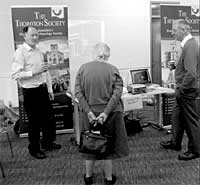
The Thoroton Society stand at The Great Nottinghamshire Local History Fair, Mansfield library. Photo: Howard Fisher.
The Society was represented at this event held on Sunday, 19 May 2013 in Mansfield library. We had a stand and displayed our two new banners together with a revolving PowerPoint presentation about the Society.The event was well supported by Local History societies from the county and other relevant organisations and it attracted a lot of public interest.
Our stand was manned by a rota of members and we were able to discuss the Society with several people who took away our leaflets to, hopefully, become members. As part of our publicity drive we gave away back-issue copies of the Newsletter and we made several sales of books. The main purpose was to spread the word about the Thoroton Society (indeed we were able to enlighten at least one person who did not know who or what we were and who took away one of our publicity leaflets). The event organisers were pleased with the number of stands and the public attendance and it is understood that there may well be repeats of the event in the future at other venues. Certainly those of us from Thoroton who manned the stand felt it was a worthwhile event to support by which to gain publicity in our ongoing drive to attract more members to Thoroton and to make the Society even better known to a wider audience. The only drawback for us was that we had been told we would have a good even light-coloured wall on which to project our PowerPoint but, when we arrived, the wall behind our allocated table had a textured finish which greatly degraded the quality of our images, something we must seek to avoid for future events.